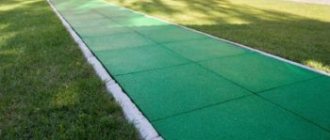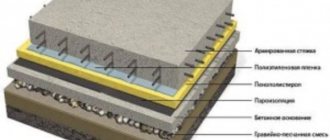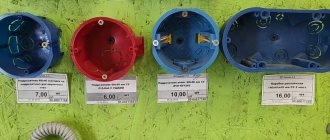- 1 What are concrete gratings?
- 2 Pros and cons
- 3 Types
- 4 Laying technology
- 5 Areas of application
- 6 Conclusion
Unusual drainage coverings have begun to appear in parking lots, sidewalks, and parking lots on private property. Concrete grating is a product that allows you to combine functionality with environmental friendliness. This product is easy to use and easy to install. Such concrete structures are gaining wide popularity. They are often installed on lawn areas and eco-parking lots.
What are concrete gratings?
The decorative product is a stamped block of concrete. Stamping is done using casting or vibration pressing. Typically, the dimensions of a lawn structure are 60 by 40 by 10 centimeters. The concrete grid has several square or diamond-shaped holes. This lattice can protect the roots of plants. So, if lawn geogrids are exposed to external influences (transport, etc.), the grass will be able to recover immediately or after irrigation. Lawn geogrid performs several functions simultaneously:
- allows you to maintain the attractiveness of the lawn;
- helps make the lawn smooth;
- protects grass roots;
- strengthens the soil;
- warns floods.
The concrete structure is installed in the soil at a shallow depth. Drainage is laid under concrete geogrids, which protects the soil from excess moisture.
Return to contents
Design Features
Thanks to the cellular structure, plant roots are well protected from damage. A drainage layer is laid under the stone slabs: through it, moisture is drained into the soil and does not stagnate on the surface. Eco-parking made of concrete is widely used on hard soils, where there are difficulties with drainage of rain and melt water.
The structure assembled from blocks is durable and resistant to shear, vertical and horizontal loads. The products are convenient to use even for sites with complex geometry.
In order for the concrete lattice to look neat for many years, and for the blocks to not fall through when laying the coating, you must follow simple recommendations. After installing the lattice elements, the cells are filled with soil and seeded with grass.
Advantages and disadvantages
Grass parking lots based on a lawn grid are becoming popular.
The lawn structure for eco-parking has many advantages that make the lattice stand out against the background of asphalt and tiles. Concrete used in the manufacture of geogrids is a good alternative to plastic modules. Such cells are stronger than their plastic counterparts. At the same time, the gratings can reliably protect the lawn: it will be preserved better than plants that were sown using traditional technology. Cars driving on the concrete support will not crush the grass, since it will be located in a niche.
Concrete geogrids have other advantages:
- grates allow rainwater to penetrate directly into the soil without interfering with plant growth;
- products are presented in different sizes and shapes of cells; in addition, it is possible to manufacture parking products according to sketches to order;
- During production, concrete mortar of different colors is used, so you can choose a shade that suits the landscape design;
- lawn or parking gratings are laid on sites; they can also become an alternative to conventional tiles, which are used for laying sidewalks.
The eco-parking structure is a universal product used in private and public areas, since its service life is at least twenty-five years. In addition, the color saturation of the cells does not disappear under the influence of ultraviolet radiation and precipitation - they remain bright for a long time. Products do not deteriorate due to the influence of low temperatures.
However, such structures also have their disadvantages that must be taken into account during installation. First of all, the material from which they are made does not allow the production of thin walls of the gratings, which often does not coincide with the architecture located nearby. It should also be taken into account that the installation of the slab material involves installation and fixation in the soil, which implies additional financial costs for the work.
Return to contents
Recommendations for selecting and applying lawn grass seeds
- Seed material of perennial grasses should be zoned to the climate conditions of the region. Rare or even exotic grass stands will require additional time and money for maintenance. Approximately 2/3 of the total number of seeds is added to the soil fill, which is approximately 3-4 g/m2. The residue is distributed over the soil surface before compaction.
- You can save working time by using biomats as a substrate. In addition to seeds, this material contains a set of fertilizers and growth stimulants, which frees the parking lot owner from adding additional fertilizing to the soil for two years.
- Before the formation of grass, the structure must be watered periodically. This responsibility continues after the installation of the solar canopy. The grass surface, deprived of rain moisture, will need periodic moistening.
The reinforcing properties of the lawn root system will appear approximately 60-70 days after seed application. During this time, it is recommended to use the parking lot in a gentle manner.
Kinds
Building materials are classified according to several main characteristics. We are talking about the shape and color of the gratings. In particular, the form depends on their purpose and happens:
- honeycomb-shaped (products can withstand loads of up to about twenty tons per square meter, so they are used when arranging sidewalks or bicycle paths, parking lots for cars and playgrounds for children);
- square (grids are intended for the construction of areas where vehicle traffic is especially intense; they are able to withstand heavy loads - about four hundred tons per square meter).
The range of cell shades is varied. Products made using coloring pigment are sold at a higher price. The most popular shade is gray, since its cost in comparison with other products is minimal. The designs also come in red, brownish, yellow, green and blue.
Return to contents
Dimensions
Lawn and parking grating options vary widely. Much depends on the weight and shape of the honeycomb for which it is designed. For example, the parameters of mesh options with a load of up to 25 tons of cellular form are 0.7 * 0.4 * 0.032 meters, and they are also used to strengthen the soil and parking lots. Analogues with a cell shape in the form of a diamond with four corners and weighing up to 25 tons are 0.6).6*0.04 meters - for eco-parking. Subtypes of square honeycombs with a load weight of up to 25 tons, which when assembled are 101 kg, have a size of 0.6 * 0.4 * 0.038 meters.
They are ideal for laying out areas under cars in the country. Options in black color, made in the form of crosses with a weight of up to 25 tons per square and have a size of 0.6 * 0.5 * 0.051 meters. They are made for country parking lots and designing paths. Grids with a size of 0.6 * 0.4 * 0.064 meters in the form of a square, and also have a maximum load of 40 tons per square, are recognized as reinforced. They are designed to create public parking spaces. They cost almost 2 times more than cellular models. Another material option is reinforced honeycomb-type squares with a size of 0.6*0.4*0.064 meters. They were designed specifically for public parking.
Laying technology
Installation work of concrete products intended for eco-parking and other areas is more difficult to carry out than the installation of plastic cells. Experts explain this by the greater mass of building materials. Some sections are difficult to lift on your own. Otherwise, the building material must be laid in the same way as sidewalk tiles. To construct the cushion, builders use crushed stone and sand. To carry out the work, you will need a rubber mallet to install the product, a rammer, stakes, a cord and a building level.
Work must be carried out in the following order:
- First you need to prepare the site - make markings, hammer in pegs, weed the turf and make a small depression in the soil (thirty centimeters).
- Then you can level the bottom and check the depth using a level.
- After this, ten centimeters of crushed stone are poured. It should be watered and compacted well.
- A sand cushion (seven to ten centimeters) is placed on top, watered and compacted.
- Cell laying. The sections are carefully tapped with a mallet, setting them to the required depth. The depth is checked using a building level.
When installing the grate in a parking lot, you don’t have to maintain the slope, since water still does not accumulate on the surface of the structure. After completion of installation in the eco-parking area, experts recommend treating the surface with tamping equipment, then filling the cells with soil and planting plants.
Return to contents
Turnkey eco-parking cost
The price consists of three components:
- preparation of the base;
- laying lawn grating;
- arrangement of lawns in cells.
To get an accurate estimate, call the phone number listed on the website and order a site survey. Our engineer will take measurements, advise on the optimal design and send a calculation by email. The final estimate will indicate the cost of work and materials for the turnkey installation of eco-parking. The table below shows approximate prices for the construction of a parking lot from a lawn lattice with an area of at least 50 square meters. m:
| Types of work when constructing a concrete parking lot | Units | Prices for work, rub. |
| Geodetic markings and elevation measurements | sq. m | 200 |
| Laying geotextiles | sq. m | 50 |
| Sand filling in a layer of 15 cm with compaction | sq. m | 580 |
| Filling of crushed stone with a layer of 15 cm with compaction | sq. m | 580 |
| Laying a lawn grate for a parking lot | sq. m | 900 |
| Installation of curb stones | p.m. | 450 |
| Filling the lawn lattice with fertile soil with seeds | sq. m | 100 |
Areas of application
Eco-parking is far from the only place where such cells can be used. They are also indispensable in other conditions:
- A city where there is a special need for water drainage.
- In areas where there is a need to move liquid over a certain distance. In this case, such building material is the most practical and cheapest.
- Drainage of melt and rain water from roofs. Through the concrete grate, the liquid penetrates into the ditch and flows into the sewer.
- In areas fenced with concrete trays, where there is never waterlogging.
- In southern regions where areas need to be watered frequently, it is useful to have a good drainage system, since the flow of liquid will be controlled.
Return to contents
Characteristics
The performance characteristics of the grating tiles are determined by the properties of the material:
- concrete is not subject to rotting or corrosion;
- subject to production technology, the monolith tolerates low and high temperatures, as well as their sharp fluctuations;
- the material does not contain components harmful to the environment or humans, is environmentally friendly and durable;
- The variety of colors and color fastness allows you to choose slabs for any design solution.
- paving paths and areas for any purpose;
- creating a decorative border;
- strengthening the shore of an artificial reservoir;
- design of a site with a complex profile.
Concrete gratings are distinguished by their ability to bear load:
- up to 20 tons per 1 sq. m - used to create coatings in private areas, in areas of intense pedestrian or bicycle traffic;
- up to 400 tons per 1 sq. m - for areas with heavy traffic (public eco-parking lots, access roads, etc.).
- square (simple) of different sizes;
- diamond-shaped (oblique);
- cellular (hexagonal);
- slabs with round holes in the canvas and semicircular recesses on the edges (when connecting 2 elements, the pattern of circles is not disturbed).











